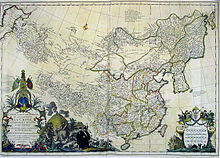- Zhili
-
This article is about the historic province of Zhili in China. For the Chinese politician, see Chen Zhili.
- for the township see Zhili Township, Hebei
Zhílì (traditional Chinese: 直隸; simplified Chinese: 直隶; Wade–Giles: Chih-li) was a northern province in China from the Ming Dynasty (1368–1644) until the province was dissolved in 1928 during the Republic of China era.
History
The name Zhili means "directly ruled" and indicates regions directly ruled by the imperial government of China. Zhili province was first constituted during the Ming Dynasty when the capital of China was located at Nanjing along the Yangtze River. In 1403, the Ming Yongle Emperor relocated the capital to Beiping, which was subsequently renamed Beijing (literally, "Northern capital").[1] The region known as Northern Zhili (Bei Zhili) was composed of parts of the modern provinces of Hebei, Henan, Shandong, and the administrative districts of Beijing and Tianjin. Conversely there was a region located around the "reserve capital" Nanjing known as Southern Zhili (Nan Zhili) that included parts of what are today the provinces of Jiangsu, Anhui, and the administrative district of Shanghai.
During the Qing Dynasty Nanjing lost its status of the "second capital", and Southern Zhili was reconstituted as a regular province, Jiangnan, while Northern Zhili was renamed Zhili Province. In the 18th century the borders of Zhili province were redrawn and spread over what is today Beijing, Tianjin and the provinces of Hebei, Western Liaoning, Northern Henan and the Inner Mongolia Autonomous Region.[citation needed] In 1928 the government of the Republic of China assigned portions of northern Zhili province to its neighbors in the north and renamed the remainder Hebei Province.
References
- ^ Susan Naquin, Peking: Temples and City Life, 1400-1900, p xxxiii
Categories:- Subdivisions of China
- Provinces of the Republic of China
- States and territories disestablished in 1928
Wikimedia Foundation. 2010.




